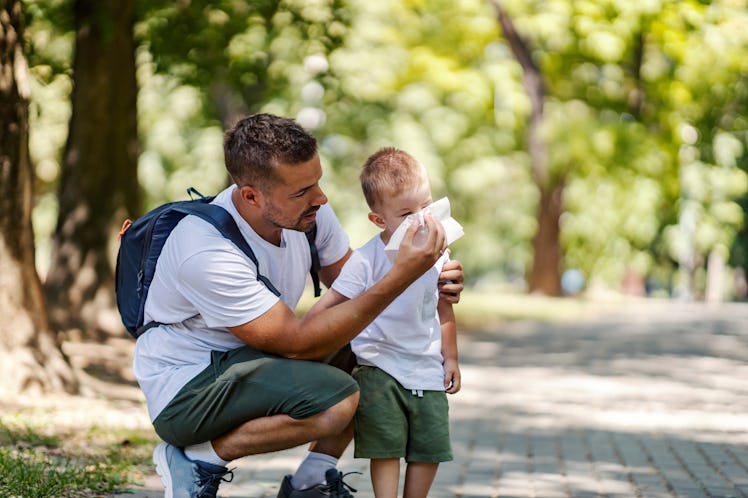What Is The Right Allergy Medicine For Kids? An Expert Weighs In

Nearly one in five kids have seasonal allergies, according to the CDC. That’s a lot of itchy throats, drippy noses, and frustrated parents frantically wondering if they’ve packed enough tissues for their current outing.
Unfortunately, there’s no real way to avoid allergies altogether. While your child’s risk of developing seasonal allergies can increase based on where you live and your family history, there’s no real way to prevent them altogether, according to Dr. Charnetta Colton-Poole, a board-certified pediatrician and author of 10 Commandments of Communication for Doctors: An Easy Guide to Help Doctors Effectively Communicate Online and Offline.
To help parents better prepare for when pollen counts are high and morale is low, we tapped Colton-Poole for advice. Below, she breaks down the basics when it comes to understanding seasonal allergies, and gives her take on the best medication to ease your child’s symptoms.
Ahead, four steps to put into your action plan if your child has seasonal allergies.
1. Determine if Your Child’s Symptoms Are Actually Allergies
Allergies are triggered when someone is exposed to a particle the body deems dangerous, called an allergen. Once exposed, the body releases various chemicals, including histamine, to protect against the allergen. So even though allergies are technically meant to defend us, they often wreak havoc on our immune systems.
When it comes to seasonal allergies and the common cold, there’s a lot of overlap in symptoms, including a runny and/or stuffy nose, watery or swollen eyes, and occasional facial pressure or heaviness. Sneezing is also a typical symptom of both. To differentiate between the two, Colton-Poole recommends considering the following: Duration of symptoms, associated symptoms, and onset of symptoms.
“Typically, allergies last much longer than the common cold, and are not usually associated with fever or other symptoms outside of those discussed [above],” Colton-Poole says. “Additionally, allergies often occur immediately after exposure compared to the gradual onset of a cold.”
2. Choose the Right Allergy Medication
As a practicing pediatrician in Georgia, Colton-Poole sees a large percentage of patients and families suffering from allergies regularly, and is used to answering parent’s questions about choosing the right allergy medicine for their kids. She typically recommends a second-generation antihistamine and regularly recommends Children’s Allegra in her practice. It’s non-drowsy, so it won’t make your child sleepy, and only requires one dose every 12 hours, so it’s easy to integrate into your child’s routine.
In addition to being the #1 allergist recommended children's non-drowsy allergy oral antihistamine, Children’s Allegra is long-lasting for up to 12 hours and available in kid-approved flavors like berry.
While every medication has its own set of side effects, Allegra is generally well-tolerated by Colton-Poole’s patients, which is another reason why she trusts the brand. (While severe reactions are rare, they should always be monitored for with any allergy medication).
3. Give Your Kids Options
Another great thing about Allegra is that it offers the same medication in two different forms, an orally dissolving tablet and a drinkable liquid. The biggest benefit of different forms of medication is that it’s suitable for children from ages 2 and up, so you can stick to one brand for the whole family (and avoid having to find a new medication as your child gets older!). Colton-Poole generally finds children 10 years and up prefer an oral tablet, while children under 10 may require a liquid or dissolvable medication.
Both Children's Allegra Liquid and their Dissolve Tabs are available over-the-counter, so you can pick it up at your local grocery store, pharmacy, or even order on Amazon.
4. Help Limit Allergen Exposure
Beyond giving your kids Allegra to help control their seasonal allergies, one of the best ways to minimize allergy symptoms is to minimize allergen exposure, says Colton-Poole. Common indoor allergens include pet dander, dust and mold. Common outdoor allergens include trees and grass.
If your child suffers from outdoor allergies, Colton-Poole recommends monitoring the pollen counts in your area, and sticking to indoor activities when it’s exceptionally high, especially if your child is sensitive. For both indoor and outdoor allergies, becoming familiar with your child’s triggers can help you limit exposure. When avoiding triggers isn’t possible, she recommends rinsing your child’s clothes and hair to remove allergens, as well as using an air purifier indoors.
Stock your medicine cabinet with the #1 allergist-recommended, non-drowsy allergy brand among OTC single-ingredient branded oral antihistamines. Learn more about Children’s Allegra here.